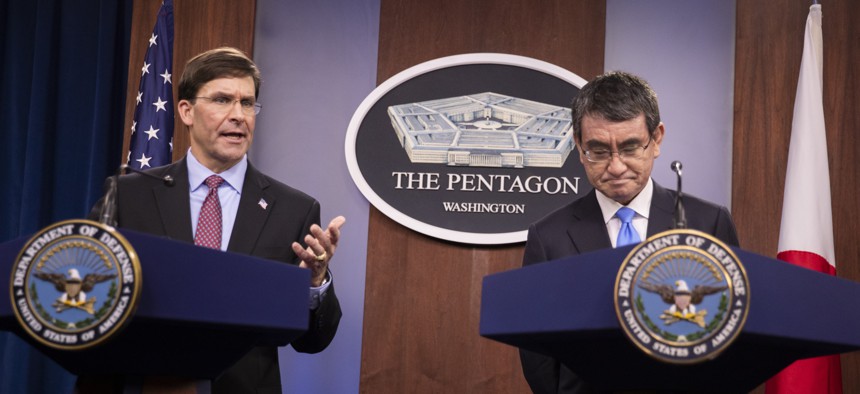
Defense Secretary Mark Esper and Japan's Defense Minister Taro Kono speak during a news conference at the Pentagon in Washington, Tuesday, Jan. 14, 2020. AP Photo/Manuel Balce Ceneta
Let Japan’s Companies Help
To stay ahead of China, the Pentagon should reach out to allies who have more advanced capabilities than the U.S. Japan is top of the list.
The increasing belligerence of China, North Korea, and Russia, bolstered by Beijing’s steady gains as a military power, has U.S. officials concerned that our technological edge is slipping dangerously. In response, it’s time for U.S. military leaders and the Pentagon’s weapons acquisition bureaucracy to usher Japanese commercial technology into the fold of our collective industrial base. Japanese companies should be working shoulder-to-shoulder with U.S. firms to field the most advanced weapons.
The need for closer coordination with Japan has never been greater. Security in the Indo-Pacific region is increasingly perilous, with the U.S. and its adversaries locked in a delicate and extremely dangerous minuet of military maneuvering every day. The Chinese government has been aggressively projecting its power throughout the region. In recent weeks, its army has clashed with India over its common border for the first time in 35 years. Its air force routinely overflies Taiwan’s airspace. Its navy sent a submarine through waters near Japan for the first time since 2018. And its rubber-stamp legislature has effectively ended Hong Kong’s “One Country, Two Systems” experiment. Meanwhile, North Korea once again has become more bellicose, as evidenced by it blowing up the Inter-Korean Joint Liaison Office in Kaesong on June 16. And Russia continues to meddle throughout the region, including regular overflights into Japanese airspace. Perhaps most worrisome, the Chinese and Russian air forces on July 21 coordinated a sortie into Japanese and South Korean airspace.
Some analysts believe that China already has surpassed the United States in some key next-gen technologies, and that Beijing’s more emboldened moves demonstrate their advances in next-generation technologies such as stealth drones, hypersonic missiles and unmanned vehicles.
The United States cannot stay ahead of or catch up with China on its own without tapping the expertise of allies. While the military has done a better job in recent years of reaching out to the American private sector for assistance with research and development prototype programs, the fact remains some of our allies have more advanced capabilities than we do.
Japan is top of the list. According to an April study from the Atlantic Council, Japanese companies have demonstrated expertise in many technical areas, including unmanned systems, defense applications of artificial intelligence, hypersonic missiles, and space. Moreover, Japan is deeply concerned about the rising threats in its backyard. Later this month, the government will consider a proposal to allow Japan’s military to preemptively strike foreign missile sites. Because of these events, the Japanese government is increasingly willing to cooperate with the United States, including partially embracing the right to collective self-defense through increased technology transfers.
There are also many other Japanese off-the-shelf, commercial technologies with military applications, such as microelectronics and 5G, that are Pentagon priorities. But sharing those technologies has been much harder.
Part of the problem lies on the Japanese side and part lies at the feet of the Pentagon. In Tokyo, Japan’s Ministry of Economy & Industry needs to modify its export control rules to allow Japanese corporations, such as Kyocera, to participate in more U.S. research and development programs with defense applications. Speaking at a recent webinar hosted by the International Security Industry Council – Japan, Kenji Wakamiya, Japanese state minister for foreign affairs, stated his government wanted the Pentagon to detail the technologies it was most interested in so Japan could change its export control rules. In Washington, not only does the Pentagon need to do this, but it must change its own rules that would allow Japanese firms to participate in these dual-use projects.
Fortunately, there is a workaround. Undersecretary of Defense for Acquisition and Sustainment Ellen Lord’s office issued a memorandum of understanding in 2019 that encouraged companies from Australia, Canada, and the United Kingdom to participate in key dual-use defense programs as preferred partners. Expanding the list of countries to include Japan not only makes sense – it is a national security imperative for the U.S.
The most recent National Defense Strategy correctly continues a shift of U.S. military priorities toward Asia, especially to counter China. To meet its goals, the Pentagon needs better technology, and fast. Bringing on board more Japanese companies will help.
Bernice Kiyo Glenn is a senior consultant with C5BDI, a strategic planning, management and business development consulting firm, and a board member of the International Security Industry Council-Japan.




